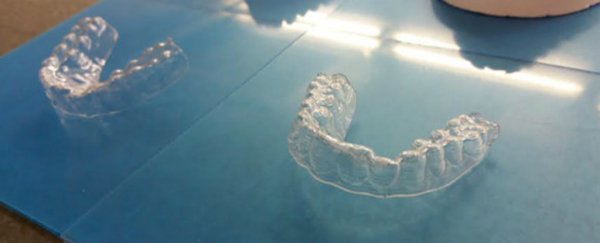A digital design student in New Jersey went viral over the weekend after 3D-printing his very own set of clear, orthodontic aligners - just like the ones that sell for thousands of dollars - all for less than US$60.
Twenty-three-year-old Amos Dudley had braces as a kid, but failed to maintain them, so was left with a crooked smile that he hated. As a poor college student, he couldn't afford more orthodontist work… but he did have access to state-of-the-art digital fabrication tools at university, so he decided to create his own aligner and see if he could fix his teeth himself. From the photos at least, it seems to be working.
You can see below his before and after images, showing 16 weeks of progress:
Dudley was inspired after researching brand name aligners and spotting the tell-tale 3D-printed layer striations in some of the up-close images. He'd seen those same striations in his own university creations.
"What is to stop someone, who has access to a 3D printer, from making their own orthodontic aligners?" writes Dudley on his blog. "Turns out, not much!"
After a lot of research into the proper orthodontic process, Dudley started by taking a mould of his teeth using alginate powder and then filled it with liquid PermaStone to set it. He then scanned the cast, and used software to digitally model the progression of his teeth towards his ultimate goal.
That's a lot trickier than it sounds - Dudley first needed to separate the teeth into different objects and plan out a route for them to travel so that they moved but didn't intersect with each other.
"Then it was just a matter of animating them into their correct positions," he writes. "I measured the total distance of travel, and divided it by the maximum recommended distance a tooth can travel per aligner. Each frame of animation was baked into a new STL model."
Using a Stratasys Dimension 1200es 3D printer from the New Jersey Institute of Technology, Dudley printed out each of the 12 models, and with a vacuum form machine, created plastic aligners over the top, using special dentist plastic he bought on eBay.
That part's important, because you can't actually print the aligners themselves, just the teeth they're modelled on - not only would 3D-printed aligners be uncomfortable, but the plastic is porous and would end up growing bacteria in your mouth. "These have to sit in the mouth without breaking down or releasing toxic chemicals, so the quality of the plastic is important," Dudley explains.
He's already been wearing the aligners day and night - only taking them out to eat - for 16 weeks, and wants to continue using them.
"As far as I know, I'm the first person to have tried DIY-ing plastic aligners. They're much more comfortable than braces, and fit my teeth quite well. I was pleased to find, when I put the first one on, that it only seemed to put any noticeable pressure on the teeth that I planned to move - a success!" he writes. "Most importantly, I feel like I can freely smile again."
But while Dudley thinks his own experiment was a success, he doesn't recommend anyone else print their own aligners - and he's not going to start doing it for others any time soon.
And that's a good thing, because while the idea works in theory, there's a reason it takes around 10 years of training to become an orthodontist.
"I'm impressed with the way [he] was able to use the scanning and printing technology that he had available to engineer and produce his own aligners but a little frightened that he would actually use them to treat himself without a professional assessment of the health and function of the teeth," practising orthodontist Brent Larson, who teaches at the University of Minnesota, told Sophie Kleeman over at Gizmodo.
"In fact, when looking at the images of the DIYer's teeth, there are specific areas of tooth wear visible that indicate unbalanced function and possible nighttime grinding."
And he's right to be worried - there have been some terrifying examples of DIY dentistry in the past.
"This isn't like home remodelling where if you get into trouble you can always call in a professional later," said Larson. "Damage could result in loss of the supporting tooth root, gum recession, or, in the worst case, loss of teeth."
But while no one's recommending you start doing your own orthodontics at home, Dudley's experiment - and the interest in it - has highlighted the fact that people are "frustrated with the state of the orthodontic appliance industry," he told BuzzFeed. "There's not enough competition, and prices are very high."
Hopefully this will put more pressure on trained, industry professionals to come up with safer and more affordable options for everyone. And isn't that what disruptive technology is all about?




